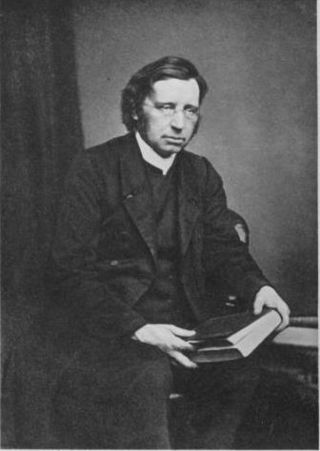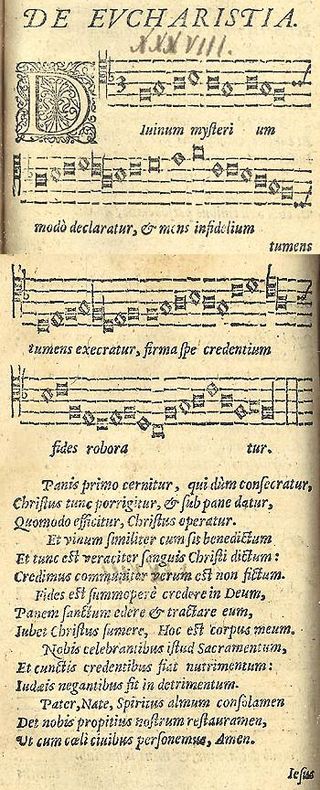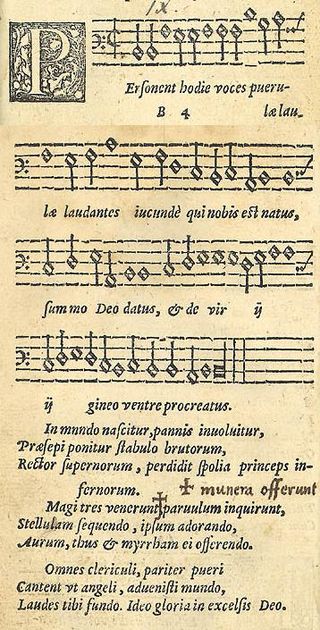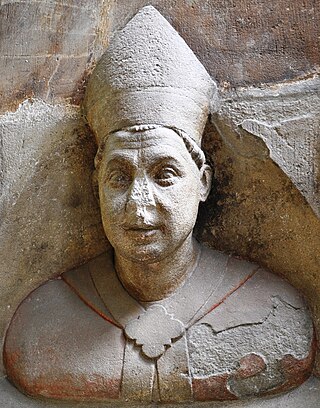
A Christmas carol is a carol on the theme of Christmas, traditionally sung at Christmas itself or during the surrounding Christmas holiday season. The term noel has sometimes been used, especially for carols of French origin. Christmas carols may be regarded as a subset of the broader category of Christmas music.
A carol is a festive song, generally religious but not necessarily connected with Christian church worship, and sometimes accompanied by a dance. A caroller is someone who sings carols, and is said to be carolling.

"Good King Wenceslas" is a Christmas carol that tells a story of a Bohemian king who goes on a journey, braving harsh winter weather, to give alms to a poor peasant on the Feast of Stephen. During the journey, his page is about to give up the struggle against the cold weather, but is enabled to continue by following the king's footprints, step for step, through the deep snow. The legend is based on the life of the Saint Wenceslaus I, Duke of Bohemia (907–935), who was not a king in his lifetime but had that status conferred on him after his death.

Gaudete is a sacred Christmas carol, thought to have been composed in the 16th century. It was published in Piae Cantiones, a collection of Finnish/Swedish sacred songs published in 1582. No music is given for the verses, but the standard tune comes from older liturgical books.

John Mason Neale was an English Anglican priest, scholar, and hymnwriter. He worked on and wrote on a wide range of holy Christian texts, including obscure medieval hymns, both Western and Eastern. Among his most famous hymns is the 1853 Good King Wenceslas, set on Boxing Day. An Anglo-Catholic, Neale's works have found positive reception in high-church Anglicanism and Western Rite Orthodoxy.

"O come, O come, Emmanuel" is a Christian hymn for Advent, which is also often published in books of Christmas carols. The text was originally written in Latin. It is a metrical paraphrase of the O Antiphons, a series of plainchant antiphons attached to the Magnificat at Vespers over the final days before Christmas. The hymn has its origins over 1,200 years ago in monastic life in the 8th or 9th century. Seven days before Christmas Eve monasteries would sing the “O antiphons” in anticipation of Christmas Eve when the eighth antiphon, “O Virgo virginum” would be sung before and after Mary's canticle, the Magnificat. The Latin metrical form of the hymn was composed as early as the 12th century.

Jaakko Mäntyjärvi is a Finnish composer of classical music, and a professional translator.

"Resonet in laudibus" is a 14th-century Christmas carol which was widely known in medieval Europe, and is still performed today. Although probably earlier, in manuscript form it first appears in the Moosburg gradual of 1360 and occurs in several 15th, 16th and 17th century printed collections from both Catholic and Lutheran traditions.

"In dulci jubilo" is a traditional Christmas carol. In its original setting, the carol is a macaronic text of German and Latin dating from the Middle Ages. Subsequent translations into English, such as J. M. Neale's arrangement "Good Christian Men, Rejoice" have increased its popularity, and Robert Pearsall's 1837 macaronic translation is a mainstay of the Christmas Nine Lessons and Carols repertoire. J. S. Bach's chorale prelude based on the tune is also a traditional postlude for Christmas services.

"Of the Father's heart begotten" alternatively known as "Of the Father's love begotten" is a doctrinal hymn based on the Latin poem "Corde natus" by the Roman poet Aurelius Prudentius, from his Liber Cathemerinon beginning "Da puer plectrum" which includes the Latin stanzas listed below.

Thomas Helmore was a choirmaster, writer about singing and author and editor of hymns and carols.

"Personent hodie" is a Christmas carol originally published in the 1582 Finnish song book Piae Cantiones, a volume of 74 Medieval songs with Latin texts collected by Jacobus Finno, a Swedish Lutheran cleric, and published by T.P. Rutha. The song book had its origins in the libraries of cathedral song schools, whose repertory had strong links with medieval Prague, where clerical students from Finland and Sweden had studied for generations. A melody found in a 1360 manuscript from the nearby Bavarian city of Moosburg in Germany is highly similar, and it is from this manuscript that the song is usually dated.

"Puer nobis nascitur", usually translated as "Unto Us Is Born a Son", is a medieval Christmas carol found in a number of manuscript sources—the 14th-century German Moosburg Gradual and a 15th-century Trier manuscript. The Moosburg Gradual itself contained a number of melodies derived from the 12th- and 13th-century organum repertories of Notre Dame de Paris and the Abbey of Saint Martial, Limoges, suggesting that its antiquity may be much greater.

"Giv mig ej glans, ej guld, ej prakt", also known simply as "Julvisa", Op. 1/4, is an art song for vocal soloist and piano written in 1909 by the Finnish composer Jean Sibelius, who set an 1887 Christmas carol by the Finnish poet Zacharias Topelius. Late in his career, Sibelius made several arrangements of "Giv mig ej glans, ej guld, ej prakt": for male choir a cappella in 1935; for voice and female choir a cappella in 1942; for two unaccompanied female voices in 1942; and for children's choir and organ in 1954.
Hemminki of Masku was a Finnish priest, hymn writer, and translator. His work, particularly Yxi Wähä Suomenkielinen Wirsikirja greatly influenced hymnody in the Finnish language.

"Jesus Christus nostra salus" is a hymn in Ecclesiastical Latin celebrating the Eucharist. It first is confirmed to have appeared in a manuscript in 1410. For a long time it was attributed to Johannes Hus, but was more likely written by the Archbishop of Prague, Jan of Jenštejn. Several hymns in different languages were derived from it, among others Martin Luther's "Jesus Christus, unser Heiland, der von uns den Gotteszorn wandt".
George John Robert Gordon was a British diplomat in South America and Europe who attracted attention in the 1870s for his marital situation. He also played a role in introducing the mediaeval song collection Piae Cantiones to a wider audience.

"Long Ago, Prophets Knew", also called "Long Ago, Prophets Knew, Christ would come born a Jew", is an English Christian Advent carol written by Reverend Fred Pratt Green in 1970.
Hymnody in continental Europe developed from early liturgical music, especially Gregorian chant. Music became more complicated as embellishments and variations were added, along with influences from secular music. Although vernacular leisen and vernacular or mixed-language carols were sung in the Middle Ages, more vernacular hymnody emerged during the Protestant Reformation, although ecclesiastical Latin continued to be used after the Reformation. Since then, developments have shifted between isorhythmic, homorhythmic, and more rounded musical forms with some lilting. Theological underpinnings influenced the narrative point of view used, with Pietism especially encouraging the use of the first person singular. In the last several centuries, many songs from Evangelicalism have been translated from English into German.
"Ye Choirs of New Jerusalem" or "Sing, Choirs of New Jerusalem" is an English Easter hymn by Robert Campbell. It is a 19th-century translation of the medieval Chorus novae Ierusalem, attributed to Fulbert of Chartres. The text's primary focus is the Resurrection of Jesus, taking the theme of Jesus as triumphant victor over death and deliverer of the prisoners from Hell.















